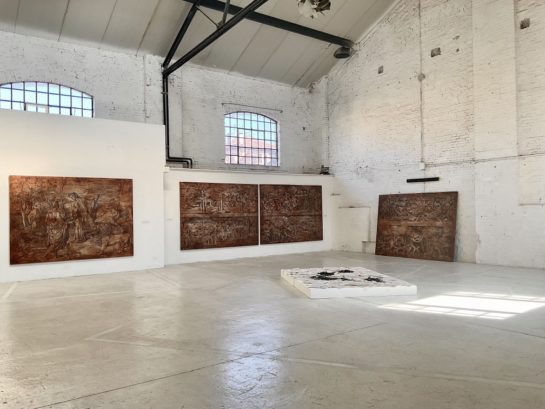Curated! Eddy Susanto solo show at GAD, Venice
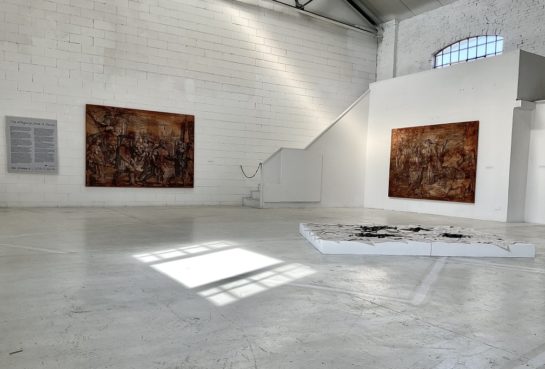
One of my favourite Southeast Asian artist, Eddy Susanto, is currently having his first solo show in Europe, and it’s in Italy, Venice, in parallel with the 59th edition of the Venice Biennale. Called “Allegory of Hell, from Borobudur to Dante ”, the show is taking place in Venice from July 28th to September 4th.
This is particularly relevant, considering that this year Indonesia doesn’t have its own national pavilion, so we thought of Eddy as a representative for the country. The show was sponsored by Artsociates, and I’m glad to say that I co-curated it with Valentina Levy at GAD, Giudecca Art District.
Eddy Susanto is renowned to create multi-layered artworks, based on in-depth and almost scholarly research into pockets of culture between the East and the West. His practice is highly intellectual yet visually striking in his scrupulous attention to detail.
Susanto came to the forefront of the artistic scene of Southeast Asia by winning the Bandung Contemporary Art Award #2 with a comparative artwork that took on European Renaissance and the entry of Islam on the island of Java. In Susanto’s “Java of Dürer” (2011) Albrecht Dürer’s engraved lines were at a closer look composed of written words from the Javanese book Babad Tanah Jawi.
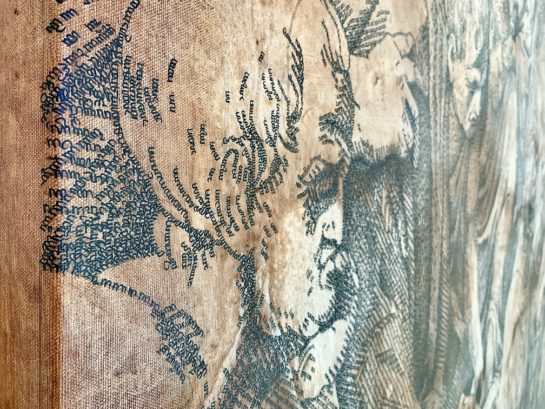
For his new series presented at GAD, titled “Java of Dante” Susanto engages again in a research-led project, based both on iconographic research and a text-based comparative study. Delving into the historical narratives and processes of identity formation, the artist looks back on his own heritage, exploring Javanese mythology and history through the reliefs of the Borobudur temple.
He draws comparisons between the representations of hell on the reliefs of the Borobudur Temple, relating to the core of Buddhism, and representing the hell and the afterlife according to the Javanese, and the illustrations Dante’s Divine Comedy over the years, from the most famous engravings of Gustave Dorè, to the lesser-known Giuseppe Bossi.
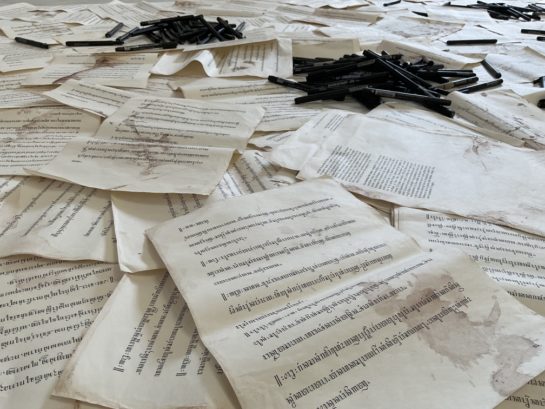
Just like the Borobudur temple presents a pyramid-like structure, Dante’s hell is represented as a reverse pyramid. The reliefs found at the foot of Borobudur’s temple depict the cause of human suffering and the result of human actions in the next life and are connected to each other to tell a story that represents the Mahakarmavibhanga Sutra, or the concept of Karma, as to each human actions there is a corresponding effect – much like in Dante’s circles of hell, where to each sin corresponds a different punishment. The pains of hell and the pleasure of heaven are also illustrated on the stones of the Javanese temple.
At the show at GAD Susanto builds on the parallelisms between these allegories of the afterlife. He is presenting ten artworks, organised in five couples, bringing side to side the Javanese reliefs with the illustrations of Dante’s Inferno, highlighting not only formal similarities in terms of poses, attitudes of the different characters, and the composition but also drawing an invisible connecting line between the conception of the Javanese afterlife and Dante’s circles of sinners.
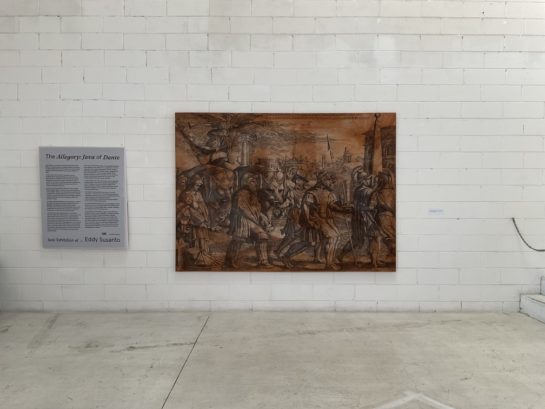
In “Java of Dante”, the artists add another layer of meaning by creating images on the canvas by using tiny embroidering of words. The pieces of texts are forming the shapes of the different characters; indeed, for Dante’s illustrations, he uses the ancient language of Java, while Borobudur reliefs are formed by Dante’s words.
“We must first understand that the human is an animal symbolicum,” says the artist. “We can observe two big ideas developing in almost the same era, in two distant parts of the world, Europe and Java. This points out to an interconnectedness in the field of consciousness, between human minds,” ponders Eddy Susanto.
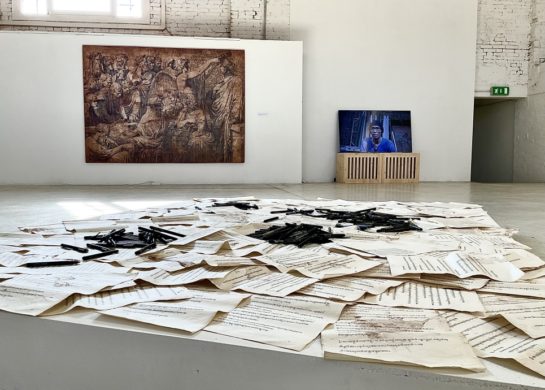
It’s not the first time that Eddy explores Dante Alighieri. He first delved into the work of the Italian author in his previous series “Transhumanism Paradox (Dante’s Divine Comedy)”, exploring the meaning of words in his seminal book.
“Java of Dante” is part of GAD’s program “Humanabilia from Mirabilis to Techne”, which constitutes a composite collective travel diary narrated through the proposals of different international curators and the works of over 50 artists, and referring to different times and traditions from East to West. The visitor will discover local imaginaries, fantastic landscapes, visions, and other “wonders” of the hyper-globalized times. These stories will converge, or they will flow, side by side, like the many canals of Venice, the city that used to be Europe’s trading gateway to the East.
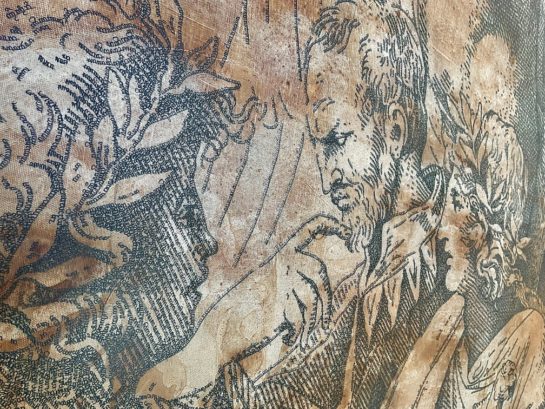
Artist’s Bio
Eddy Susanto lives and works in Yogyakarta. His artworks are research-based, exploring the notions of historical narratives and the development of identity. They portray fragments of local history parallel to the world’s history, interpolating the East’s cultural identity into the historical elements of the West.
Eddy’s paintings are mostly incorporating Javanese passages in their native hanacaraka script, taken from several important Javanese works of literature. His series of Sembilan Mata Hari Centhini (2012), for example, was created around the analogy found between the character of Mata Hari and the dance movements described in Serat Centhini. His works titled Java of Dürer (2011) – the artwork that earned him the accolade of Bandung Contemporary Art Award #2 – replace Albrecht Dürer’s engraved lines with passages from Babad Tanah Jawi.
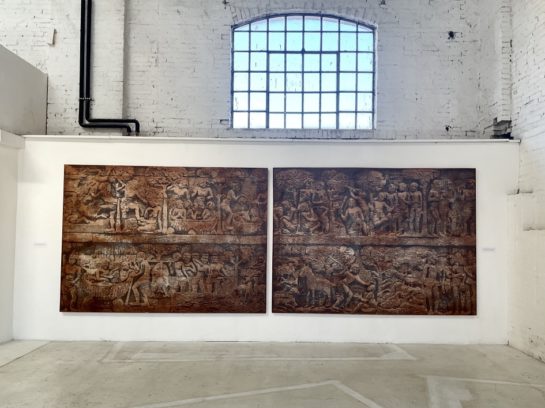
ArtSociates
ArtSociates is an art and artist management enterprise established on 2007 by Andonowati as part of Foundation AB. Its principal objective is to promote Indonesian artists into a broader audiences, in national scope as well as the international sphere. In conjunction with that, as an entity it also sets its focus on creative industry management, aiming to create an art park that oversees the development and innovations in art and culture.
As a mean to that end, ArtSociates manages and nurtures its representative artists by strengthening the fundamentals to their intrinsic qualities. At the same time, it also sees the distribution of their artworks, while working on the improvement of their portfolios’ quality. Furthermore, ArtSociates actively seeks new and groundbreaking talents through their biennial award program, Bandung Contemporary Art Award.
Currently, ArtSociates is working on Poros Bandung project and a museum complex for maestros of Mazhab Bandung.
